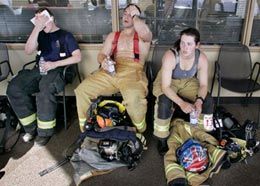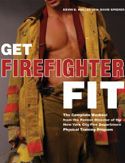By Kevin Malley and David Spierer
‘Get Firefighter Fit’
 AP Photo/Elaine Thompson Firefighters recuperate after the Seattle charity stair climb. |
Training is a lot like taking your family on vacation. First you decide where you want to go, then you do a little research and map it out. Finally, just before leaving, you get the car thoroughly serviced for the ride. Can you imagine jumping into the car with your wife and kids for a cross-country trip and just trying to wing it? Forget about it — that’s a recipe for disaster!
Physical training is essentially the same: If you launch into a physical training program blindly, the prospect for success is remote. No matter how enthusiastic you are at the start, a reckless or haphazard approach to training most often leads to frustration and failure.
STEP 1. Select Your Primary Goal
The first important step in the training process is to clearly define your primary training goal(s). In firefighting, determining the primary goal of an operation is generally quite easy as it almost always centers on the functions of saving lives and/or protecting property. In training, however, the spectrum of primary goals is much broader. This can make the selection process a bit more challenging.
One approach that we’ve found to be successful in assisting athletes in their efforts to determine their primary training goal(s) is to have them ask themselves a few simple questions. The first, of course, is the classic, “What is it that you really want to achieve?” For some people this is a relatively easy question to answer; for others, however, it is not. If the answer doesn’t pop right out, don’t be alarmed. Just ask yourself a couple of slightly more specific questions, such as: “Are you training to improve your performance in the fire field or to just shed a few unwanted (fat) pounds?”
STEP 2. Develop Your Personalized Training Program
Having identified one or more primary training goals, your next task is to select the appropriate form(s) of training and specific types of conditioning exercises to enable your targeted development. This is another very important step in the process, so once again give your selections some considerable thought. Remember, each exercise is an important piece of the training puzzle. As you make your selections and piece them together to form creative training routines, you’ll observe your personal training strategy coming to life. It’s actually pretty exciting work. Good coaches, in particular, love this part of the process.
In terms of your selections, it’s important to understand absolutely that the best form of training and type of training exercises for you are those which are most effective at producing the enhancements you desire. Therefore, the type of training that best fits your needs is the one that develops the specific muscles, energy-producing (metabolic) pathways and other systems that you wish to improve.
STEP 3. Train Consistently
Consistency is the absolute key to training success. As important as all of the other components of your training program may be, the only way that you’re going to progress, improve and achieve your training goals is by training on a consistent basis. Somehow you need to find a way to either make or take the time routinely to break loose and get it done. Chances are this won’t be easy. In fact, finding the time to train on a given day may be more challenging than the workout itself.
| Related Resources | ||
By the NVFC | ||
By FireRescue1 Columnist Richard C. Maddox, FDSOA Vice Chairman | ||
On NVFC.org | ||
We recommend that you take a good, hard look at your daily schedule. Check to see if there are any routine periods of availability and try to find the most practical and painless way of fitting a brief training session into your daily life. For many people, these intervals of availability wind up being either before work, after work or during lunch. If this is the case with you, then the next logical step is to decide which of these periods is most consistently convenient or the easiest to do. Try to be realistic. If you’re not, and your training conflicts with other important priorities (like sleep or dinner with the family), you’re doomed to the same fate as the millions who did so before you: failure.
STEP 4. Build Gradual, Intelligent Progressions
Most people fail in self-initiated training efforts because they set their initial training goals much too high. They wind up doing too much too soon, and then drop out as a consequence of frustration, undue discomfort or injury. In the words of FDNY Fire Marshal (retired) Mike Andreachi, “They blast off and burn out like nickel rockets.” Why? Because with the best of intentions and great enthusiasm they bite off much more than they can chew. They create workouts for themselves that are too long, too difficult and too painful. This negative experience results in a subconscious desire to quit. The desire grows quickly, and, before long, they quit. Don’t make this same fatal mistake: Design your program to succeed; start out nice and easy. Remember, when it comes to beginning a new program, “light is right” and, very often, “less is more.”
The roles of psychology and psychological perspective in training cannot be denied. In order to succeed in your training, you have to stay motivated, and in order to stay motivated you need some form of consistent positive feedback. Consistent positive feedback can be obtained through steady achievement. This is best accomplished through the completion of a well-designed, progressive series of realistic short-term goals.
To successfully build upon your initial gains, you should gradually increase the frequency (number of sessions each week) of your workouts, progressively building to the point where you’re training aerobically nearly every day and/or strength training three or four times a week. The second progressive adjustment that you should consider making would be to increase the duration (length, time or distance of sessions) of your workouts. Finally, after developing a sound training foundation, you should consider elevating the intensity (how hard you train) of your sessions.
STEP 5. Balanced Training
The human body is an amazing bio-machine, miraculously responding to vigorous challenges by improving its ability to better handle them in the future. Think about it: You exercise a muscle to the point of exhaustion, and the body’s automatic response is to increase that muscle’s ability to better resist fatigue. It’s an incredible feature to possess; all you have to do is support it by eating the right foods, staying well hydrated and getting sufficient rest.
Maintaining a proper balance between exercise and rest is crucial to producing rapid and significant gains. The key is to maintain the balance. Sometimes this is easy but other times it’s not, particularly at the onset of a program when your motivation is at its peak, or a little further down the road where dramatic early gains provide abundant positive feedback. Be careful not to over do it in the beginning, and try not to get carried away with yourself as a result of early successes.
STEP 6. Get Yourself Checked Out
Before launching into a rigorous training routine, you need to be certain that your body is absolutely ready to contend with the intense demands. Getting yourself checked out by a physician prior to beginning a new program is therefore an excellent idea. Many medical conditions such as heart disease and high blood pressure can develop without producing any noticeable symptoms and therefore exist without you ever becoming aware. For this reason, they are referred to as “silent killers.” “You don’t want the joker popping up in the deck."1 Suffering a preventable heart attack is the exact opposite of what you’re trying to achieve. Have your physician minimize that ill-fated potential prior to the onset of your training.
Firefighters should receive a comprehensive medical/physical exam prior to employment, and then annually throughout the term of their careers. Your approach should be the same. Get yourself checked out by a physician prior to launching into a new physical training program, especially if you’ve already celebrated your 40th birthday. Again, using the analogy of preparing for a family trip: the older the car, the more important a thorough inspection before the ride.
STEP 7. Conduct Assessments
Once you’re medically cleared and ready to begin training, you need to determine the current abilities of the specific muscles and related body systems that you wish to develop. You can achieve this by conducting basic pre-test measures of the fitness element(s) and parameter(s) you wish to improve. In the FDNY academy, we achieved this through the use of fundamental fitness tests like the 1.5-mile run, bent-knee sit-ups, push-ups and reverse-grip pull-ups. You can easily conduct your own personal aerobic fitness test by running, cycling or swimming in whatever venue or environment you intend to train: the track, road or local pool. The same goes for resistance training. Just head on down to your basement or the gym in which you intend to train and measure your initial ability to perform each exercise of your workout routine.
STEP 8. Use Appropriate Equipment
When selecting the proper clothing and equipment for your training, there’s no better rule of thumb to apply than simply using the right tool for the job. Training attire and equipment should be chosen on the basis of their abilities to facilitate training gains and performance. The type of activity, session intensity and duration, level of ability and weather all play a role in determining what clothing is best to wear and what equipment is best to use. Just give it some thought and try to use what is safest and most productive rather than what just happens to be handy or is the least expensive. You don’t have to spend a fortune to acquire good clothing and equipment, but if you go for the low-end product, there’s a good chance that you’ll get precisely what you paid for. If you get injured as a result of using inexpensive poor-quality clothing and equipment, then all of a sudden, “cheap becomes expensive.”
 |
Kevin Malley is the chairperson of the fire science department at New Jersey City University. As a member of the FDNY for more than 22 years, he worked in engine, ladder and special operations units as a firefighter and fire officer. In 1996, he was appointed as the FDNY director of human performance, where he was responsible for the physical conditioning programs for the department’s firefighter, EMS and civilian personnel. David Spierer is an assistant professor and director of the human performance laboratory in the division of sports sciences at Long Island University in Brooklyn, New York. Their new book, “Get Firefighter Fit,” aims to develop the fitness level and physique of firefighters. Profits from the book will go to a scholarship in honor of two of Malley’s many colleagues who died in 9/11. To order it, visit Amazon.com.











